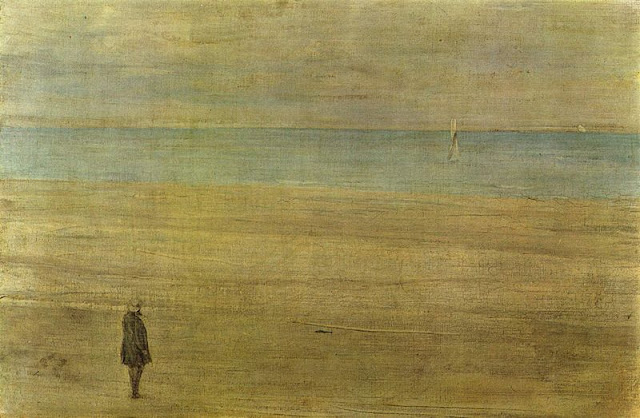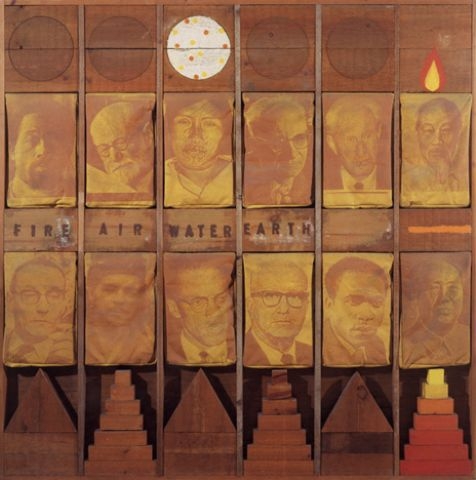 |
| Portrait of Whistler by Walter Greaves |
James (Abbott) McNeill Whistler was born in Lowell, Massachusetts in 1834. He spent five years of his childhood (1843-1848) in St. Petersburg, Russia, where his father, a railway engineer, was employed in the building of the St. Petersburg to Moscow railway. As a young man Whistler changed his middle name ‘Abbott’ for his mother’s maiden name ‘McNeill’. In St. Petersburg young James received his first art lessons in the Imperial Academy of Fine Arts and also learnt French.
Whistler’s father died in 1849 and his mother decided to take the family back to America, settling at Pomfret, Connecticut, where James attended the local school until, in 1851, he entered West Point, the military academy, as his father had done before him. West Point at the time was an exclusive school where cadets were selected by Congressmen. The fact that his father had trained at West Point probably secured his entry. Never becoming a military man, Whistler remembered the three years spent at the academy with affection. Among all subjects Whistler succeeded only in drawing, special difficulties were caused by chemistry, which at last became the reason of his ejection from the academy. "Had silicon been a gas," he later declared, "I would have been a General-Major."
West Point was followed by a brief period of employment in the United States Geodetic and Coast Survey offices in Washington. In 1855, Whistler arrived in Paris, the artistic capital of Europe, with the intention of becoming an artist.
After a short period at the École Impériale et Spéciale de Dessin, he enrolled at the studio of Charles-Gabriel Gleyre (1806-74). At Gleyre’s, Whistler became part of the ‘Paris Gang’, a group of young English artists that included Edward Poynter (1836-1919), later president of the Royal Academy, Thomas Armstrong (1832-1911), Thomas Lamont (1826-98) and George du Maurier (1834-96).
In 1858, Whistler set out on a tour of Alsace-Lorraine and the Rhineland, during which he made a set of etchings Twelve Etchings from Nature, better known as the French Set. Praise of the work encouraged Whistler to continue etching. Between 1858 and 1863 he produced 80 plates, Rotherhithe (1860), among them.
 |
| 1860 Rotherhithe |
 |
| 1858-9 At the Piano |
 |
| 1862 Symphony in White No 1: The White Girl |
In 1866, Whistler traveled to South America where the Chileans were engaged in a war against Spain, he kept a journal of naval and military developments but avoided involvement in any fighting.
In 1877, Whistler began to paint a series of ‘Nocturnes’ based on the Thames views at night. One of his most famous works in this series in Nocturne: Blue and Gold – Old Battersea Bridge, originally called ‘Moonlights’. His patron, Frederick Leyland, an enthusiastic pianist, suggested the term ‘Nocturne’. Whistler replied, ‘I can’t thank you too much for the name Nocturne as the title for my Moonlights. You have no idea what an irritation it proves to the critics, and consequent pleasure to me; besides it is really so charming, and does so poetically say all I want to say and no more than I wish.’
 |
| 1877 Nocturne in Blue and Gold: Old Battersea Bridge |
 |
| 1875 Nocturne in Black and Gold: The Falling Rocket oil on wood |
 |
| 1876 Peacock Room |
 |
| 1886 Harmony in Red: Lamplight |
 |
| 1871 Arrangement in Grey and Black: Portrait of the Painter's Mother oil on canvas |
 |
| 1872-3 Arrangement in Grey and Black No 2: Portrait of Thomas Carlyle |
Other works by James McNeill Whistler - more in part 2:
 |
| 1860-61 Harmony in Green and Rose: The Music Room |
 |
| 1861-4 Wapping |
 |
| 1862 The Last of Old Westminster Bridge |
 |
| 1864 Purple and Rose: The Lange Leizen of the Six Marks |
 |
| 1864 Rose and Silver: The Princess from the Land of Porcelain |
 |
| 1864 Symphony in White No 2: The Little White Girl |
 |
| 1865 Harmony in Blue and Silver: Trouville |
 |
| 1865 The Artist's Studio |
 |
| 1865-7 Symphony in White No 3 |
 |
| 1866 Nocturne in Blue and Gold: Valparaiso Bay |
 |
| 1868-78c Three Figures: Pink and Grey |
 |
| 1871 Nocturne: Blue and Silver - Chelsea |
 |
| 1871 Symphony in Grey: Early Morning Thames |
 |
| 1871-3 Symphony in Flesh Colour and Pink: Portrait of Mrs Frances Leyland |
 |
| 1871-4c Nocturne in Grey and Gold: Westminster Bridge |
 |
| 1872 Nocturne: Blue and Silver - Cremorne Lights |
 |
| 1872-4 Harmony in Grey and Green: Miss Cicely Alexander |



































